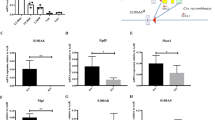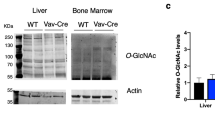Abstract
The in vivo regulation of hematopoietic stem cell (HSC) function is poorly understood. Here, we show that hematopoietic repopulation can be augmented by administration of a glycogen synthase kinase-3 (GSK-3) inhibitor to recipient mice transplanted with mouse or human HSCs. GSK-3 inhibitor treatment improved neutrophil and megakaryocyte recovery, recipient survival and resulted in enhanced sustained long-term repopulation. The output of primitive Lin−c-Kit+Sca-1+ cells and progenitors from HSCs increased upon GSK-3 inhibitor treatment without altering secondary repopulating ability, suggesting that the HSC pool is maintained while overall hematopoietic reconstitution is increased. GSK-3 inhibitors were found to modulate gene targets of Wnt, Hedgehog and Notch pathways in cells comprising the primitive hematopoietic compartment without affecting mature cells. Our study establishes GSK-3 as a specific in vivo modulator of HSC activity, and suggests that administration of GSK-3 inhibitors may provide a clinical means to directly enhance the repopulating capacity of transplanted HSCs.
This is a preview of subscription content, access via your institution
Access options
Subscribe to this journal
Receive 12 print issues and online access
$209.00 per year
only $17.42 per issue
Buy this article
- Purchase on Springer Link
- Instant access to full article PDF
Prices may be subject to local taxes which are calculated during checkout






Similar content being viewed by others
References
Baron, F., Storb, R. & Little, M.T. Hematopoietic cell transplantation: five decades of progress. Arch. Med. Res. 34, 528–544 (2003).
Giralt, S. Bone marrow transplant in myelodysplastic syndromes: new technologies, same questions. Curr. Hematol. Rep. 3, 165–172 (2004).
Vollweiler, J.L., Zielske, S.P., Reese, J.S. & Gerson, S.L. Hematopoietic stem cell gene therapy: progress toward therapeutic targets. Bone Marrow Transplant. 32, 1–7 (2003).
Moscardo, F., Sanz, G.F. & Sanz, M.A. Unrelated-donor cord blood transplantation for adult hematological malignancies. Leuk. Lymphoma 45, 11–18 (2004).
Cohena, Y. & Nagler, A. Hematopoietic stem-cell transplantation using umbilical-cord blood. Leuk. Lymphoma 44, 1287–1299 (2003).
Rocha, V. et al. Transplants of umbilical-cord blood or bone marrow from unrelated donors in adults with acute leukemia. N. Engl. J. Med. 351, 2276–2285 (2004).
Laughlin, M.J. et al. Outcomes after transplantation of cord blood or bone marrow from unrelated donors in adults with leukemia. N. Engl. J. Med. 351, 2265–2275 (2004).
Srour, E.F., Abonour, R., Cornetta, K. & Traycoff, C.M. Ex vivo expansion of hematopoietic stem and progenitor cells: are we there yet? J. Hematother. 8, 93–102 (1999).
Devine, S.M., Lazarus, H.M. & Emerson, S.G. Clinical application of hematopoietic progenitor cell expansion: current status and future prospects. Bone Marrow Transplant. 31, 241–252 (2003).
Chabot, B., Stephenson, D.A., Chapman, V.M., Besmer, P. & Bernstein, A. The proto-oncogene c-kit encoding a transmembrane tyrosine kinase receptor maps to the mouse W locus. Nature 335, 88–89 (1988).
Geissler, E.N., Ryan, M.A. & Housman, D.E. The dominant-white spotting (W) locus of the mouse encodes the c-kit proto-oncogene. Cell 55, 185–192 (1988).
Frame, S. & Cohen, P. GSK-3 takes centre stage more than 20 years after its discovery. Biochem. J. 359, 1–16 (2001).
Cohen, P. The hormonal control of glycogen metabolism in mammalian muscle by multivalent phosphorylation. Biochem. Soc. Trans. 7, 459–480 (1979).
Embi, N., Rylatt, D.B. & Cohen, P. Glycogen synthase kinase-3 from rabbit skeletal muscle. Separation from cyclic-AMP-dependent protein kinase and phosphorylase kinase. Eur. J. Biochem. 107, 519–527 (1980).
Yost, C. et al. The axis-inducing activity, stability, and subcellular distribution of beta-catenin is regulated in Xenopus embryos by glycogen synthase kinase 3. Genes Dev. 10, 1443–1454 (1996).
Jia, J. et al. Shaggy/GSK3 antagonizes Hedgehog signalling by regulating Cubitus interruptus. Nature 416, 548–552 (2002).
Foltz, D.R., Santiago, M.C., Berechid, B.E. & Nye, J.S. Glycogen synthase kinase-3b modulates Notch signaling and stability. Curr. Biol. 12, 1006–1011 (2002).
Murdoch, B. et al. Wnt-5A augments repopulating capacity and primitive hematopoietic development of human blood stem cells in vivo. Proc. Natl. Acad. Sci. USA 100, 3422–3427 (2003).
Reya, T. et al. A role for Wnt signalling in self-renewal of haematopoietic stem cells. Nature 423, 409–414 (2003).
Bhardwaj, G. et al. Sonic hedgehog induces the proliferation of primitive human hematopoietic cells via BMP regulation. Nat. Immunol. 2, 172–180 (2001).
Karanu, F.N. et al. The notch ligand jagged-1 represents a novel growth factor of human hematopoietic stem cells. J. Exp. Med. 192, 1365–1372 (2000).
Duncan, A.W. et al. Integration of Notch and Wnt signaling in hematopoietic stem cell maintenance. Nat. Immunol. 6, 314–322 (2005).
Cline, G.W. et al. Effects of a novel glycogen synthase kinase-3 inhibitor on insulin-stimulated glucose metabolism in Zucker diabetic fatty (fa/fa) rats. Diabetes 51, 2903–2910 (2002).
Ring, D.B. et al. Selective glycogen synthase kinase 3 inhibitors potentiate insulin activation of glucose transport and utilization in vitro and in vivo. Diabetes 52, 588–595 (2003).
Morrison, S.J. & Weissman, I.L. The long-term repopulating subset of hematopoietic stem cells is deterministic and isolatable by phenotype. Immunity 1, 661–673 (1994).
Larochelle, A. et al. Identification of primitive human hematopoietic cells capable of repopulating NOD/SCID mouse bone marrow: Implications for gene therapy. Nat. Med. 2, 1329–1337 (1996).
Bhatia, M., Wang, J.C., Kapp, U., Bonnet, D. & Dick, J.E. Purification of primitive human hematopoietic cells capable of repopulating immune-deficient mice. Proc. Natl. Acad. Sci. USA 94, 5320–5325 (1997).
Behrens, J. et al. Functional interaction of an axin homolog, conductin, with beta-catenin, APC, and GSK3beta. Science 280, 596–599 (1998).
DasGupta., R. & Fuchs, E. Multiple roles for activated LEF/TCF transcription complexes during hair follicle development and differentiation. Development 126, 4557–4568 (1999).
Yan, D. et al. Elevated expression of axin2 and hnkd mRNA provides evidence that Wnt/beta-catenin signaling is activated in human colon tumors. Proc. Natl. Acad. Sci. USA 98, 14973–14978 (2001).
Jho, E.H. et al. Wnt/beta-catenin/Tcf signaling induces the transcription of Axin2, a negative regulator of the signaling pathway. Mol. Cell. Biol. 22, 1172–1183 (2002).
Issack, P.S. & Ziff, E.B. Altered expression of helix-loop-helix transcriptional regulators and cyclin D1 in Wnt-1-transformed PC12 cells. Cell Growth Differ. 9, 837–845 (1998).
Varnum-Finney, B. et al. Pluripotent, cytokine-dependent, hematopoietic stem cells are immortalized by constitutive Notch1 signaling. Nat. Med. 6, 1278–1281 (2000).
Jarriault, S. et al. Signalling downstream of activated mammalian Notch. Nature 377, 355–358 (1995).
Marigo, V., Johnson, R.L., Vortkamp, A. & Tabin, C.J. Sonic hedgehog differentially regulates expression of GLI and GLI3 during limb development. Dev. Biol. 180, 273–283 (1996).
Marigo, V. & Tabin, C.J. Regulation of Patched by Sonic hedgehog in the developing neural tube. Proc. Natl. Acad. Sci. USA 93, 9346–9351 (1996).
Goodrich, L.V., Milenkovic, L., Higgins, K.M. & Scott, M.P. Altered neural cell fates and medulloblastoma in mouse patched mutants. Science 277, 1109–1113 (1997).
Calvi, L.M. et al. Osteoblastic cells regulate the haematopoietic stem cell niche. Nature 425, 841–846 (2003).
Reya, T. Regulation of hematopoietic stem cell self-renewal. Recent Prog. Horm. Res. 58, 283–295 (2003).
Sato, N., Meijer, L., Skaltsounis, L., Greengard, P. & Brivanlou, A.H. Maintenance of pluripotency in human and mouse embryonic stem cells through activation of Wnt signaling by a pharmacological GSK-3-specific inhibitor. Nat. Med. 10, 55–63 (2004).
Mancini, S.J. et al. Jagged1-dependent Notch signaling is dispensable for hematopoietic stem cell self-renewal and differentiation. Blood 105, 2340–2342 (2005).
Cobas, M. et al. Beta-catenin is dispensable for hematopoiesis and lymphopoiesis. J. Exp. Med. 199, 221–229 (2004).
Shojaei, F. et al. Hierarchical and ontogenic positions serve to define the molecular basis of human hematopoietic stem cell behavior. Dev. Cell. 8, 651–663 (2005).
Cohen, P. & Goedert, M. GSK3 inhibitors: Development and therapeutic potential. Nat. Rev. Drug Discov. 3, 479–487 (2004).
Barker, J.N. et al. Transplantation of 2 partially HLA-matched umbilical cord blood units to enhance engraftment in adults with hematologic malignancy. Blood 105, 1343–1347 (2005).
Gluckman, E. Current status of umbilical cord blood hematopoietic stem cell transplantation. Exp. Hematol. 28, 1197–1205 (2000).
Tsirigotis, M. et al. Analysis of ubiquitination in vivo using a transgenic mouse model. Biotechniques 31, 120–130 (2001).
Nikoulina, S.E. et al. Inhibition of glycogen synthase kinase 3 improves insulin action and glucose metabolism in human skeletal muscle. Diabetes 51, 2190–2198 (2002).
Acknowledgements
We would like to thank Chiron Corporation for providing the GSK-3 inhibitors for these studies, and M. Scott for providing the Ptc1+/−lacZ transgenic mice. We acknowledge L. Gallacher for technical assistance, K. Levac and P. Menendez for critical review of the manuscript, D. Sheerar for cell isolation, the nurses of the labor and delivery division of St. Joseph's Health Care and London Health Sciences Centre for collection of cord blood samples. Funding for this research was provided by a research grant from the Canadian Institutes of Health Research, US National Institutes of Health grant P01 GM069983 (to R.T.M.), the Krembil Foundation, Ontario Research Fund, Canada Research Chair in Stem Cell Biology and Regenerative Medicine (to M.B.), and postgraduate scholarship awards from the Ontario Graduate Society and National Cancer Institute of Canada (to J.J.T.). R.T.M. is an investigator of the Howard Hughes Medical Institute.
Author information
Authors and Affiliations
Corresponding author
Ethics declarations
Competing interests
The authors declare no competing financial interests.
Supplementary information
Supplementary Fig. 1
Progenitor (CFU) capacity and NOD/SCID repopulation activity of primitive mouse bone marrow subsets. (PDF 67 kb)
Supplementary Fig. 2
Administration of GSK-3 inhibitor and survival following sublethal irradiation in the absence of transplanted mouse HSCs. (PDF 30 kb)
Supplementary Table 1
Primer sequences used for real-time PCR amplification. (PDF 58 kb)
Rights and permissions
About this article
Cite this article
Trowbridge, J., Xenocostas, A., Moon, R. et al. Glycogen synthase kinase-3 is an in vivo regulator of hematopoietic stem cell repopulation. Nat Med 12, 89–98 (2006). https://doi.org/10.1038/nm1339
Received:
Accepted:
Published:
Issue Date:
DOI: https://doi.org/10.1038/nm1339
This article is cited by
-
GSK-3: a multifaceted player in acute leukemias
Leukemia (2021)
-
Creatine kinase pathway inhibition alters GSK3 and WNT signaling in EVI1-positive AML
Leukemia (2019)
-
Targeting JNK pathway promotes human hematopoietic stem cell expansion
Cell Discovery (2019)
-
Maintenance of human haematopoietic stem and progenitor cells in vitro using a chemical cocktail
Cell Discovery (2018)
-
Distinct gene expression program dynamics during erythropoiesis from human induced pluripotent stem cells compared with adult and cord blood progenitors
BMC Genomics (2016)



